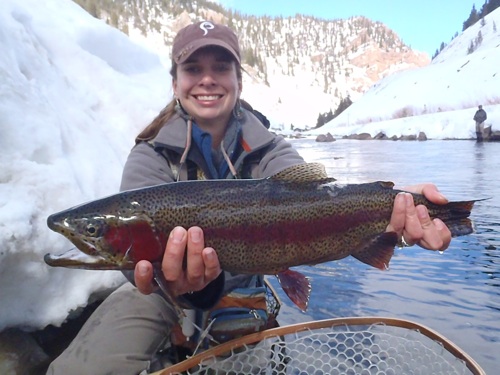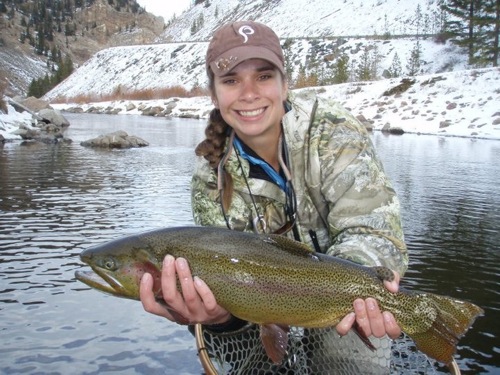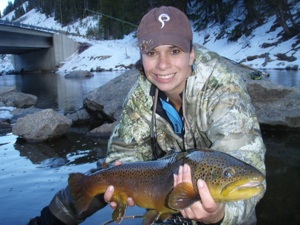DamselFly Fisher: Big Trout Tip #3 — Safe Handling Techniques
 Landing a nice trout is so exciting that people often forget themselves and handle their fish in ways that could harm or even kill the prize they just caught. These tips are all meant for catch-and-release fishing. The following tips will help ensure that the fish you catch will continue to live long and healthy lives, produce numerous offspring and develop into even more magnificent fish in years to come.
Landing a nice trout is so exciting that people often forget themselves and handle their fish in ways that could harm or even kill the prize they just caught. These tips are all meant for catch-and-release fishing. The following tips will help ensure that the fish you catch will continue to live long and healthy lives, produce numerous offspring and develop into even more magnificent fish in years to come.
-

Katherine Browne and a quick photo of a beautiful 'bow. Photo by Eric Grand.
- Land your trout as quickly as possible. The longer you fight a fish, the more lactic acid builds up in their muscles and high levels of lactic acid will kill trout. Exhaustion is one of the biggest killers of trout. Even if your fish swims away does not mean it will survive. Using the appropriate tippet size will greatly aid in efficiently landing a fish. You are not going to be able to land a 24-plus-inch trout on 8x in a reasonable amount of time. Also, see Tip #1 for more tips on steering and landing trout quickly.
- All fish deserve humane treatment. Trout that I am not taking a photo of I usually don’t even remove from the water. I always have a pair of hemostats on me to remove hooks and I release trout as quickly as possible. There are many tools available on the market for quickly and safely removing hooks. If you do handle a fish, wet your hands thoroughly before touching the fish. This helps protect their slime coat, which is their protection from disease and injury. Handle fish with you bare hands whenever possible or use gloves designed for handling fish that will not remove their slime coat.
- Invest in a good rubber net. Cheap nylon nets are terrible on fish and strip off their slime coat. There are many inexpensive rubber nets available on the market so there is no excuse for using a nylon or cloth net. Rubber nets also don’t snag hooks as easily and are generally nicer for landing fish.
- Revive the fish before releasing it. In moving water, point the fish’s nose upstream to allow the water to move through its gills. Don’t place it in muddy water that had been stirred up by your boots. Many people cradle the fish in their hands while it revives, but I often keep them in my net underwater until they are ready to go. Make sure the fish is upright while reviving it. In still water you can move the fish gently forward and back to help move water through it’s gills. When it is ready to go, it will usually take off like a shot.

And yet another catch ... Katherine Browne, DamselFly Fisher! Photo by Eric Grand.
- Fish with flies! Fly fishing is much safer on fish for many reasons. Fish don’t swallow flies like bait. As soon as a fish feels an artificial fly on its palate, it spits it out. That why you have to be so quick with your hook set while fly fishing. I always find it funny when clients tell me they had a nibble. There are no nibbles in fly fishing – only grabs and spits. Fish barbless hooks or crimped barbs whenever possible; it’s easier to lose fish this way but it’s less likely fish will be injured. NEVER fish treble hooks for catch and release. I HATE treble hooks; they are terrible on fish and a good angler should be able to catch a fish with one hook. When I have had spinner trips in the past I clipped off two of the hooks and crimped the barb on the last.
- Take photos as quickly as possible. I am guilty of loving to take a photo of a good trout, but it drives me crazy when I see people keeping a fish out of water for a long time to take photos. The longer you keep a fish out of the water, the lower its chances are of surviving. My fiancé, Eric, and I have perfected the quick trout photo. NEVER pick up trout by the jaw or gill plate. Trout live their lives horizontally in suspension and picking them up by the jaw can tear their organs and dislocate their spine and jaw, especially in large trout. I put my camera on rapid-fire mode so I can get several pictures in seconds. I crouch and hold the fish directly over the water so if I lose control of the fish for some reason it will land in the water and not on land where it will injure itself. Also, the fish is within inches of the water so it doesn’t have a long way to fall. If I am alone, I take a photo of the fish in my rubber net in shallow water before releasing it. I like to hold the fish out away from my body with one hand cupping the base of the tail and one hand below its head, holding it horizontally. Do not squeeze the fish hard while holding it. If you are worried about losing the fish, you can cradle it over your net in the water. This makes for a great quick photo, and then get that fish back in the water!
Tight lines and thanks for reading!

Guess who? With another fish, of course. Photo by Eric Grand.
The Conversation
 Landing a nice trout is so exciting that people often forget themselves and handle their fish in ways that could harm or even kill the prize they just caught. These tips are all meant for catch-and-release fishing. The following tips will help ensure that the fish you catch will continue to live long and healthy lives, produce numerous offspring and develop into even more magnificent fish in years to come.
Landing a nice trout is so exciting that people often forget themselves and handle their fish in ways that could harm or even kill the prize they just caught. These tips are all meant for catch-and-release fishing. The following tips will help ensure that the fish you catch will continue to live long and healthy lives, produce numerous offspring and develop into even more magnificent fish in years to come.
Katherine I thoroughly enjoyed this great lesson. I am almost ashamed to admit I truly knew little about the best catch and release methods as most of my fishing is done to fill the larder. Thank you for such a great lesson!